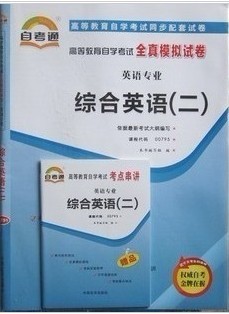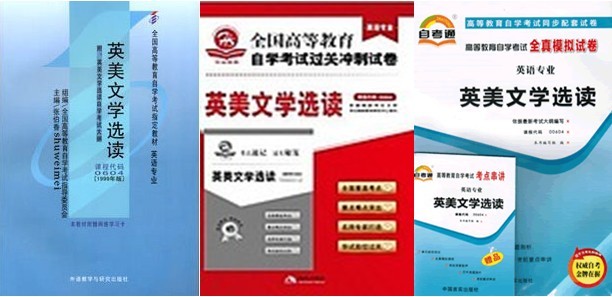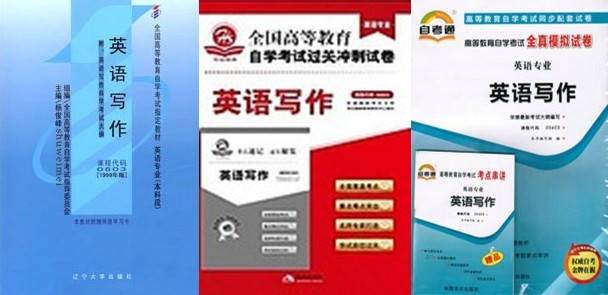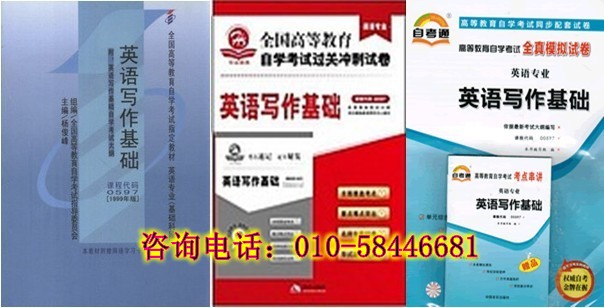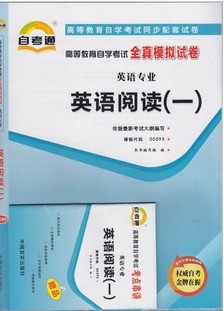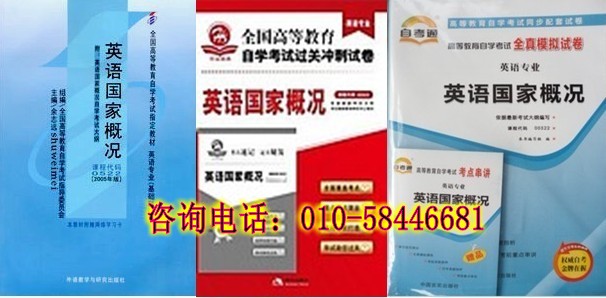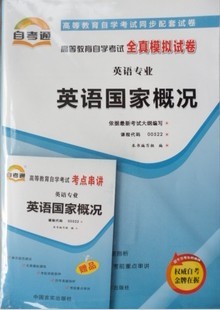
00831 现代英语语法-自考教材
内容简介
00831 现代英语语法-自考教材
本书作者:李基安
出 版 社:外语教学与研究出版社
出版日期:2000年4月第2版 2008年7月第15次印刷
开 本:32开
I S B N : 978-7-5600-1522-4
定 价:21.90
本书目录
Chapter 1 The Structure of the English Sentence
1.0 Introduction
1.1 Morphemes
1.2 Words
1.2.1 Word classes
1.2.2 Word-formation
a. Affixation
b. Composition
c. Conversion
d. Blending
e. Back-formation
f. Shortening
g. Acronyms
1.3 Phrases
1.3.1 The noun phrase
1.3.2 The verb phrase
1.3.3 The adjective phrase
1.3.4 The adverb phrase
1.3.5 The prepositional phrase
1.4 Clauses
1.4.1 Subject and predicate
1.4.2 Clause patterns
1.4.3 Functions
1.5 Sentences
1.5.1 Simple, compound and complex sentences
1.5.2 Statements, commands, questions and exclamations
1.6 The text
1.7 Exercises
Chapter 2 Sentence Types
2.0 Introduction
2.1 Statements
2.1.1 Assertion vs. non-assertion
2.1.2 Negation
a. Choice of negative words
b. Scope of negation
c. Transferred negation
2.1.3 Other functions of statements
2.2 Questions
2.2.1 YES-NO questions
2.2.2 WH-questions
2.2.3 Alternative questions
2.2.4 Tag questions
a. Forms and meanings
b. Irregular question tags
2.3 Commands
2.4 Exclamations
2.4.1 WHAT-exclamations
2.4.2 HOW-exclamations
2.5 Exercises
Chapter 3 Noun and Noun Phrase (1): Noun and Number
3.0 Introduction
3.1 Noun classes
3.2 Number
3.2.1 Singular invariables
a. Proper nouns
b. Mass nouns
3.2.2 Plural invariables
3.2.3 Irregular plurals
a. Irregular spelling/pronunciation
b. Zero plurals
c. Foreign plurals
d. Plural compounds
e. Plural of letters, numerals, abbreviations, etc.
3.3 Unit nouns
3.3.1 Unit nouns listed in alphabetical order
3.3.2 Unit nouns classified
3.4 Exercises
Chapter 4 Noun and Noun Phrase (2): Determiner and Genitive
4.1 Determiners
4.1.1 Functions of determiners
4.1.2 Co-occurrence of determiners
4.1.3 Usage of some determiners
a. all and whole
b. all and both
c. all, every and each
d. both, each and either
e. any, either, no (none) and neither
4.1.4 Articles
a. Pronunciation
b. Generic reference vs. specific reference
c. Indefinite article a (n)
d. Definite article the
4.2 Genitives
4.2.1 Forms of genitive
4.2.2 Genitive vs. of-phrase
a. Genitive
b. Of-phrase
c. Genitive and of-phrase
4.2.3 Group genitive
4.2.4 Local genitive
4.2.5 Double genitive
4.3 Exercises
Chapter 5 Verb and Verb Phrase (1): Tense, Aspect and Future
5.0 Introduction
5.0.1 Classification of verbs
5.0.2 System of two tenses and two aspects
5.1 Tense
5.1.1 Simple present
a. Simple present referring to the present
b. Simple present referring to the past
c. Simple present referring to the future
5.1.2 Simple past
a. Simple past referring to the past
b. Simple past referring to the present
c. Simple past referring to the future
5.2 Aspect
5.2.1 Present progressive
a. Present progressive referring to the present
b. Present progressive referring to the past
c. Present progressive referring to the future
d. Progressive verbs and non-progressive verbs
5.2.2 Past progressive
a. Past progressive referring to the past
b. Past progressive referring to the present or the future
5.2.3 Present perfect and present perfect progressive
a. Present perfect referring to a state, a habit or an event
b. Present perfect vs. simple past
c. Finished/unfinished use and present perfect progressive
d. Adverbials and constructions associated with present perfect
5.2.4 Past perfect and past perfect progressive
a. Finished/unfinished use and past perfect progressive
b. Hypothetical use of past perfect
5.3 Future
5.3.1 Will/shall do sth. (see 7.2 for more details)
5.3.2 Be going to do sth.
5.3.3 Present progressive
5.3.4 Simple present
5.3.5 Other constructions expressing future time
a. Will/(shall) be doing sth.
b. Be about to do sth.
c. Be to do sth.
5.4 Exercises
Chapter 6 Verb and Verb Phrase (2): Passive Voice and Subjunctive Mood
6.0 Introduction
6.1 Passive voice
6.1.1 Be-passive, get-passive and pseudo-passive
6.1.2 Voice constraints
a. Grammatical constraints
b. Semantic constraints
c. Stylistic constraints
6.1.3 By-phrase
6.1.4 Passive voice of multi-word verbs
a. Verb + preposition
b. Verb + particle
c. Verb + particle + preposition
d. Verb + noun phrase + preposition
6.1.5 Passive voice of non-finite verbs
6.2 Subjunctive mood
6.2.1 Be-subjunctive
a. Formulaic be-subjunctive
b. Mandative be-subjunctive
c. Other uses of be-subjunctive
6.2.2 Were-subjunctive
6.3 Exercises
Chapter 7 Verb and Verb Phrase (3): Modal Auxiliaries
7.0 Introduction
7.1 Can and may
7.1.1 Can/could
7.1.2 May/might
7.1.3 Can vs. may
7.2 Will and shall
7.2.1 Will/would(’ll/’d)
7.2.2 Shall/(should)
7.3 Should and ought to
7.3.1 Should
7.3.2 Ought to
7.3.3 Should vs. ought to
7.4 Must, need and have (got) to
7.4.1 Must
7.4.2 Need
7.4.3 Have (got) to
7.5 Dare
7.6 Exercises
Chapter 8 Verb and Verb Phrase (4): Non-finite Verbs
8.0 Introduction
8.1 Infinitive
8.1.1 Bare infinitive
a. Aux + verb
b. Idiomatic verb constructions
c. Rather/sooner than
d. Do
e. Why
8.1.2 To-infinitive
a. Verb + infinitive
b. Verb + object + infinitive
c. Verb + (object) + infinitive
8.1.3 Other uses of infinitive
8.2 -ing participle
8.2.1 Object to verb
8.2.2 Logical subject
8.2.3 Infinitive of –ing participle
a. Begin, cease, continue, start
b. Like, love, hate
c. Deserve, need, require, want
d. Remember, forget, go on
e. Mean, regret, try
f. Advise, allow, encourage, permit, recommend
8.3 -ed participle
8.3.1 -ed participle as a premodifier
8.3.2 -ed participle as a complement
a. Subject complement
b. Object complement
8.4 Dangling participle
8.5 Exercises
Chapter 9 Adjective Phrase and Comparison
9.0 Introduction
9.1 Syntactic features of adjectives
9.1.1 Structure of the adjective phrase
9.1.2 Attributive adjectives and predicative adjectives
a. Attributive adjectives
b. Predicative adjectives
9.2 Semantic classification of adjectives
9.2.1 Stative adjectives vs. dynamic adjectives
9.2.2 Gradable adjectives vs. non-gradable adjectives
9.2.3 Inherent adjectives vs. non-inherent adjectives
9.2.4 Restrictive adjectives vs. non-restrictive adjectives
9.2.5 Marked adjectives vs. unmarked adjectives
9.3 Ordering of premodifying adjectives
9.4 Comparison
9.4.1 Forms of comparison
a. Regular inflection
b. Irregular inflection
9.4.2 Usage notes
a. Elder and older
b. Farther and further
c. Less and fewer
d. Lesser
e. The
f. The more...the more...
9.4.3 Comparative constructions
a. As...as...
b. More...than...
c. The most...
9.4.4 Ellipsis in comparative sentences
9.4.5 Other expressions of comparison
9.5 Exercises
Chapter 10 Preposition and Prepositional Phrase
10.0 Introduction
10.1 Forms of prepositions
10.1.1 Simple prepositions
10.1.2 Complex prepositions
10.2 Meanings of prepositions
10.2.1 Prepositions relating to Place
a. At, on and in
b. Over, above, under and below
c. Between and among
d. Aboard the ship, etc.
e. From above, etc.
10.2.2 Prepositions relation to time
a. At, on and in
b. Time expressions without prepositions
10.2.3 Prepositions denoting other relations
10.3 Collocations of prepositions with verbs, adjectives and nouns
10.4 Exercises
Chapter 11 Coordination and Subordination
11.0 Introduction
11.1 Coordination
11.1.1 Coordinators
a. And and related coordinators
b. Or and related coordinators
c. But and related coordinators
11.1.2 Punctuation between coordinated units
11.2 Subordination
11.2.1 Subordinators
11.2.2 Subordinate clauses
a. Finite subordinate clauses
b. Non-finite and verbless clauses
11.2.3 Exercise
Chapter 12 Relative Clause
12.0 Introduction
12.1 Restrictiveness and non-restrictiveness
12.2 Antecedent
12.2.1 Nominal antecedent
a. Antecedent + restrictive relative clause
b. Antecedent + non-restrictive relative clause
c. Antecedent + restrictive/non-restrictive relative clause
12.2.2 Non-nominal antecedent
a. Clause as antecedent
b. Verb phrase as antecedent
c. Predicative adjective as antecedent
12.3 Choice of relative pronouns
12.3.1 Relative pronouns in restrictive relative clauses
a. Pronouns for personal antecedents
b. Pronouns for non-personal antecedents
c. Relative adverbs
12.3.2 Relative pronouns in non-restrictive relative clauses
12.4 Double relative clause
12.5 Exercises
Chapter 13 Adverbials
13.0 Introduction
13.1 Adjuncts
13.1.1 Time adjuncts
a. Types of time adjuncts
b. Positions of time adjuncts
13.1.2 Place adjuncts
a. Types of place adjuncts
b. Positions of place adjuncts
13.1.3 Proccess adjuncts
a. Manner-adjuncts
b. Instrument-adjuncts
c. Agentive-adjuncts
13.1.4 Contingency adjuncts
a. Reason-adjuncts
b. Result-adjuncts
c. Purpose-adjuncts
d. Concession-adjuncts
e. Condition-adjuncts
13.1.5 Other adjuncts
13.2 Disjuncts
13.3 Conjuncts
a. Enumeration-conjuncts
b. Addition-conjuncts
c. Transition-conjuncts
d. Summation-conjuncts
e. Explanation-conjuncts
f. Contrast-conjuncts
g. Result-conjuncts
h. Inference-conjuncts
i. Concession-conjuncts
13.4 Exercises
Chapter 14 Concord
14.0 Introduction
14.1 Principles of concord
14.2 Subject-verb concord
14.2.1 Collective nouns as subject
14.2.2 Coordinated noun phrases as subject
14.2.3 Expressions of quantity as subject
a. Subject with numerals
b. Subject with indefinite quantifiers
14.2.4 Nominal clauses as subject
14.2.5 Concord in the existential sentence
14.2.6 Concord in the relative clause
14.3 Pronoun concord
14.4 Exercises
Chapter 15 Information structure and Emphasis
15.0 Introduction
15.1 Information structure
15.1.1 Given and new information
15.1.2 Information focus
15.2 Postponement
15.2.1 Passive voice
15.2.2 Extraposition
a. Extraposed clausal subject
b. Extraposed clausal object
15.2.3 Discontinuity
15.2.4 Other types of postponement
15.3 Fronting
15.4 Inversion
15.4.1 Partial inversion
15.4.2 Complete inversion
15.5 Cleaving
15.5.1 Cleft sentence
15.5.2 Pseudo-cleft sentence
15.6 Existential sentence
15.6.1 Information structure of existential sentence
15.6.2 Grammatical features of existential sentence
15.7 Exercises
Chapter 16 Cohesion
16.0 Introduction
16.1 Reference
16.1.1 Reference by pronouns
16.1.2 Reference by demonstratives
16.1.3 Reference by comparison
16.2 Substitution
16.2.1 Nominal substitution by one
16.2.2 Verbal substitution by do
16.2.3 Clausal substitution by so or not
16.3 Ellipsis
16.3.1 Nominal ellipsis
16.3.2 Verbal ellipsis
16.3.3 Clausal ellipsis
16.4 Other cohesive devices
16.4.1 Transition
16.4.2 Repetition
16.4.3 Parallelism
16.5 Exercises
Appendix I Noun + Preposition
Appendix II Preposition + Noun
Appendix III Verb + Preposition
Appendix IV Adjective + Preposition
Bibliography
后记
1.0 Introduction
1.1 Morphemes
1.2 Words
1.2.1 Word classes
1.2.2 Word-formation
a. Affixation
b. Composition
c. Conversion
d. Blending
e. Back-formation
f. Shortening
g. Acronyms
1.3 Phrases
1.3.1 The noun phrase
1.3.2 The verb phrase
1.3.3 The adjective phrase
1.3.4 The adverb phrase
1.3.5 The prepositional phrase
1.4 Clauses
1.4.1 Subject and predicate
1.4.2 Clause patterns
1.4.3 Functions
1.5 Sentences
1.5.1 Simple, compound and complex sentences
1.5.2 Statements, commands, questions and exclamations
1.6 The text
1.7 Exercises
Chapter 2 Sentence Types
2.0 Introduction
2.1 Statements
2.1.1 Assertion vs. non-assertion
2.1.2 Negation
a. Choice of negative words
b. Scope of negation
c. Transferred negation
2.1.3 Other functions of statements
2.2 Questions
2.2.1 YES-NO questions
2.2.2 WH-questions
2.2.3 Alternative questions
2.2.4 Tag questions
a. Forms and meanings
b. Irregular question tags
2.3 Commands
2.4 Exclamations
2.4.1 WHAT-exclamations
2.4.2 HOW-exclamations
2.5 Exercises
Chapter 3 Noun and Noun Phrase (1): Noun and Number
3.0 Introduction
3.1 Noun classes
3.2 Number
3.2.1 Singular invariables
a. Proper nouns
b. Mass nouns
3.2.2 Plural invariables
3.2.3 Irregular plurals
a. Irregular spelling/pronunciation
b. Zero plurals
c. Foreign plurals
d. Plural compounds
e. Plural of letters, numerals, abbreviations, etc.
3.3 Unit nouns
3.3.1 Unit nouns listed in alphabetical order
3.3.2 Unit nouns classified
3.4 Exercises
Chapter 4 Noun and Noun Phrase (2): Determiner and Genitive
4.1 Determiners
4.1.1 Functions of determiners
4.1.2 Co-occurrence of determiners
4.1.3 Usage of some determiners
a. all and whole
b. all and both
c. all, every and each
d. both, each and either
e. any, either, no (none) and neither
4.1.4 Articles
a. Pronunciation
b. Generic reference vs. specific reference
c. Indefinite article a (n)
d. Definite article the
4.2 Genitives
4.2.1 Forms of genitive
4.2.2 Genitive vs. of-phrase
a. Genitive
b. Of-phrase
c. Genitive and of-phrase
4.2.3 Group genitive
4.2.4 Local genitive
4.2.5 Double genitive
4.3 Exercises
Chapter 5 Verb and Verb Phrase (1): Tense, Aspect and Future
5.0 Introduction
5.0.1 Classification of verbs
5.0.2 System of two tenses and two aspects
5.1 Tense
5.1.1 Simple present
a. Simple present referring to the present
b. Simple present referring to the past
c. Simple present referring to the future
5.1.2 Simple past
a. Simple past referring to the past
b. Simple past referring to the present
c. Simple past referring to the future
5.2 Aspect
5.2.1 Present progressive
a. Present progressive referring to the present
b. Present progressive referring to the past
c. Present progressive referring to the future
d. Progressive verbs and non-progressive verbs
5.2.2 Past progressive
a. Past progressive referring to the past
b. Past progressive referring to the present or the future
5.2.3 Present perfect and present perfect progressive
a. Present perfect referring to a state, a habit or an event
b. Present perfect vs. simple past
c. Finished/unfinished use and present perfect progressive
d. Adverbials and constructions associated with present perfect
5.2.4 Past perfect and past perfect progressive
a. Finished/unfinished use and past perfect progressive
b. Hypothetical use of past perfect
5.3 Future
5.3.1 Will/shall do sth. (see 7.2 for more details)
5.3.2 Be going to do sth.
5.3.3 Present progressive
5.3.4 Simple present
5.3.5 Other constructions expressing future time
a. Will/(shall) be doing sth.
b. Be about to do sth.
c. Be to do sth.
5.4 Exercises
Chapter 6 Verb and Verb Phrase (2): Passive Voice and Subjunctive Mood
6.0 Introduction
6.1 Passive voice
6.1.1 Be-passive, get-passive and pseudo-passive
6.1.2 Voice constraints
a. Grammatical constraints
b. Semantic constraints
c. Stylistic constraints
6.1.3 By-phrase
6.1.4 Passive voice of multi-word verbs
a. Verb + preposition
b. Verb + particle
c. Verb + particle + preposition
d. Verb + noun phrase + preposition
6.1.5 Passive voice of non-finite verbs
6.2 Subjunctive mood
6.2.1 Be-subjunctive
a. Formulaic be-subjunctive
b. Mandative be-subjunctive
c. Other uses of be-subjunctive
6.2.2 Were-subjunctive
6.3 Exercises
Chapter 7 Verb and Verb Phrase (3): Modal Auxiliaries
7.0 Introduction
7.1 Can and may
7.1.1 Can/could
7.1.2 May/might
7.1.3 Can vs. may
7.2 Will and shall
7.2.1 Will/would(’ll/’d)
7.2.2 Shall/(should)
7.3 Should and ought to
7.3.1 Should
7.3.2 Ought to
7.3.3 Should vs. ought to
7.4 Must, need and have (got) to
7.4.1 Must
7.4.2 Need
7.4.3 Have (got) to
7.5 Dare
7.6 Exercises
Chapter 8 Verb and Verb Phrase (4): Non-finite Verbs
8.0 Introduction
8.1 Infinitive
8.1.1 Bare infinitive
a. Aux + verb
b. Idiomatic verb constructions
c. Rather/sooner than
d. Do
e. Why
8.1.2 To-infinitive
a. Verb + infinitive
b. Verb + object + infinitive
c. Verb + (object) + infinitive
8.1.3 Other uses of infinitive
8.2 -ing participle
8.2.1 Object to verb
8.2.2 Logical subject
8.2.3 Infinitive of –ing participle
a. Begin, cease, continue, start
b. Like, love, hate
c. Deserve, need, require, want
d. Remember, forget, go on
e. Mean, regret, try
f. Advise, allow, encourage, permit, recommend
8.3 -ed participle
8.3.1 -ed participle as a premodifier
8.3.2 -ed participle as a complement
a. Subject complement
b. Object complement
8.4 Dangling participle
8.5 Exercises
Chapter 9 Adjective Phrase and Comparison
9.0 Introduction
9.1 Syntactic features of adjectives
9.1.1 Structure of the adjective phrase
9.1.2 Attributive adjectives and predicative adjectives
a. Attributive adjectives
b. Predicative adjectives
9.2 Semantic classification of adjectives
9.2.1 Stative adjectives vs. dynamic adjectives
9.2.2 Gradable adjectives vs. non-gradable adjectives
9.2.3 Inherent adjectives vs. non-inherent adjectives
9.2.4 Restrictive adjectives vs. non-restrictive adjectives
9.2.5 Marked adjectives vs. unmarked adjectives
9.3 Ordering of premodifying adjectives
9.4 Comparison
9.4.1 Forms of comparison
a. Regular inflection
b. Irregular inflection
9.4.2 Usage notes
a. Elder and older
b. Farther and further
c. Less and fewer
d. Lesser
e. The
f. The more...the more...
9.4.3 Comparative constructions
a. As...as...
b. More...than...
c. The most...
9.4.4 Ellipsis in comparative sentences
9.4.5 Other expressions of comparison
9.5 Exercises
Chapter 10 Preposition and Prepositional Phrase
10.0 Introduction
10.1 Forms of prepositions
10.1.1 Simple prepositions
10.1.2 Complex prepositions
10.2 Meanings of prepositions
10.2.1 Prepositions relating to Place
a. At, on and in
b. Over, above, under and below
c. Between and among
d. Aboard the ship, etc.
e. From above, etc.
10.2.2 Prepositions relation to time
a. At, on and in
b. Time expressions without prepositions
10.2.3 Prepositions denoting other relations
10.3 Collocations of prepositions with verbs, adjectives and nouns
10.4 Exercises
Chapter 11 Coordination and Subordination
11.0 Introduction
11.1 Coordination
11.1.1 Coordinators
a. And and related coordinators
b. Or and related coordinators
c. But and related coordinators
11.1.2 Punctuation between coordinated units
11.2 Subordination
11.2.1 Subordinators
11.2.2 Subordinate clauses
a. Finite subordinate clauses
b. Non-finite and verbless clauses
11.2.3 Exercise
Chapter 12 Relative Clause
12.0 Introduction
12.1 Restrictiveness and non-restrictiveness
12.2 Antecedent
12.2.1 Nominal antecedent
a. Antecedent + restrictive relative clause
b. Antecedent + non-restrictive relative clause
c. Antecedent + restrictive/non-restrictive relative clause
12.2.2 Non-nominal antecedent
a. Clause as antecedent
b. Verb phrase as antecedent
c. Predicative adjective as antecedent
12.3 Choice of relative pronouns
12.3.1 Relative pronouns in restrictive relative clauses
a. Pronouns for personal antecedents
b. Pronouns for non-personal antecedents
c. Relative adverbs
12.3.2 Relative pronouns in non-restrictive relative clauses
12.4 Double relative clause
12.5 Exercises
Chapter 13 Adverbials
13.0 Introduction
13.1 Adjuncts
13.1.1 Time adjuncts
a. Types of time adjuncts
b. Positions of time adjuncts
13.1.2 Place adjuncts
a. Types of place adjuncts
b. Positions of place adjuncts
13.1.3 Proccess adjuncts
a. Manner-adjuncts
b. Instrument-adjuncts
c. Agentive-adjuncts
13.1.4 Contingency adjuncts
a. Reason-adjuncts
b. Result-adjuncts
c. Purpose-adjuncts
d. Concession-adjuncts
e. Condition-adjuncts
13.1.5 Other adjuncts
13.2 Disjuncts
13.3 Conjuncts
a. Enumeration-conjuncts
b. Addition-conjuncts
c. Transition-conjuncts
d. Summation-conjuncts
e. Explanation-conjuncts
f. Contrast-conjuncts
g. Result-conjuncts
h. Inference-conjuncts
i. Concession-conjuncts
13.4 Exercises
Chapter 14 Concord
14.0 Introduction
14.1 Principles of concord
14.2 Subject-verb concord
14.2.1 Collective nouns as subject
14.2.2 Coordinated noun phrases as subject
14.2.3 Expressions of quantity as subject
a. Subject with numerals
b. Subject with indefinite quantifiers
14.2.4 Nominal clauses as subject
14.2.5 Concord in the existential sentence
14.2.6 Concord in the relative clause
14.3 Pronoun concord
14.4 Exercises
Chapter 15 Information structure and Emphasis
15.0 Introduction
15.1 Information structure
15.1.1 Given and new information
15.1.2 Information focus
15.2 Postponement
15.2.1 Passive voice
15.2.2 Extraposition
a. Extraposed clausal subject
b. Extraposed clausal object
15.2.3 Discontinuity
15.2.4 Other types of postponement
15.3 Fronting
15.4 Inversion
15.4.1 Partial inversion
15.4.2 Complete inversion
15.5 Cleaving
15.5.1 Cleft sentence
15.5.2 Pseudo-cleft sentence
15.6 Existential sentence
15.6.1 Information structure of existential sentence
15.6.2 Grammatical features of existential sentence
15.7 Exercises
Chapter 16 Cohesion
16.0 Introduction
16.1 Reference
16.1.1 Reference by pronouns
16.1.2 Reference by demonstratives
16.1.3 Reference by comparison
16.2 Substitution
16.2.1 Nominal substitution by one
16.2.2 Verbal substitution by do
16.2.3 Clausal substitution by so or not
16.3 Ellipsis
16.3.1 Nominal ellipsis
16.3.2 Verbal ellipsis
16.3.3 Clausal ellipsis
16.4 Other cohesive devices
16.4.1 Transition
16.4.2 Repetition
16.4.3 Parallelism
16.5 Exercises
Appendix I Noun + Preposition
Appendix II Preposition + Noun
Appendix III Verb + Preposition
Appendix IV Adjective + Preposition
Bibliography
后记
温馨提示
欢迎您选择北京考试书店,在这里,我们向您承诺,本书店出售图书均为正版图书,请您放心购买!
如您在下订单的时候遇到难题,欢迎您随时咨询我们的客服人员;
咨询热线:13520801473;在线QQ:1119846269;
如您对我们的书店有任何建议,欢迎您发邮件给我们,我们的邮箱:service@bookskys.com
北京考试书店祝您购物愉快!
如您在下订单的时候遇到难题,欢迎您随时咨询我们的客服人员;
咨询热线:13520801473;在线QQ:1119846269;
如您对我们的书店有任何建议,欢迎您发邮件给我们,我们的邮箱:service@bookskys.com
北京考试书店祝您购物愉快!
汇款账号
汇款户名:庹珍珍
中国工商银行帐号:6222 0202 0004 8271 965
中国农业银行帐号:6228 4800 1051 6883 112
中国银行帐号:6013 8201 0001 5744 736
中国邮政银行帐号:6221 8810 0006 5935 785
中国建设银行账号: 6227 0000 1286 0174 562
支付宝账号:tuozhenzhen88@126.com
中国工商银行帐号:6222 0202 0004 8271 965
中国农业银行帐号:6228 4800 1051 6883 112
中国银行帐号:6013 8201 0001 5744 736
中国邮政银行帐号:6221 8810 0006 5935 785
中国建设银行账号: 6227 0000 1286 0174 562
支付宝账号:tuozhenzhen88@126.com
相关图书
英语专业分类
推荐图书
- ·05844 国际商务英语考试教材+模
- ·00832 英语词汇学考试教材+模拟
- ·00831 现代英语语法考试教材+模
- ·00795 综合英语(二)考试教材+
- ·00795 综合英语(二)-自学考试
- ·00794 综合英语(一)考试教材+
- ·00794 综合英语(一)-自考过关
- ·00604 英美文学选读考试教材+模
- ·00603 英语写作考试教材+模拟试
- ·00600 高级英语(上下册)考试教
- ·00597 英语写作基础考试教材+模
- ·00596 英语阅读(二)考试教材+
- ·00596 英语阅读(二)-自学考试
- ·00595 英语阅读(一)考试教材+
- ·00595 英语阅读(一)-自学考试
- ·00522 英语国家概况考试教材+模
- ·00522 英语国家概况-自学考试全
- ·00088 基础英语(上下册)考试教
- ·00088 基础英语-自学考试全真模
- ·00087 英汉翻译教程考试教材+模
考试资讯
- ·2013年贵州社会工作者考试报名时间
- ·2013年河北社会工作者考试报名时间
- ·2013年云南社会工作者考试报名时间
- ·贵州2013年监理工程师执业资格考试
- ·江西2013年环境影响评价师考试报名
- ·宁波2013年监理工程师执业资格考试
- ·河北2013年监理工程师考务工作通知
- ·福建2013年环境影响评价师考试报名
- ·河北2013年二级建造师考务通知
- ·2013年宁夏专升本考试报名时间3月
- ·2013年河北注册税务师考试报名时间
- ·2013年广西注册税务师考试报名时间
- ·2013天津市上半年会计从业资格考试
- ·2013年广西社会工作者考试准考证打
- ·2013年广西社会工作者考试缴纳报名
- ·2013年广西社会工作者考试现场资格
- ·2013年广西社会工作者考试报名时间
- ·2013年江苏淮安社会工作者考试报名
- ·2013江苏南通社会工作者考试报名2
- ·2013年江苏南京社会工作者报名截止









